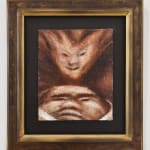



Tony Fomison
Life and Death, 1989
oil on jute laid onto board
280 x 230mm
480 x 420mm framed
480 x 420mm framed
Copyright The Artist and Gow Langsford Gallery
Further images
Faces are a subject matter that dominate many of Tony Fomison’s paintings. Often distorted and looming, they encapsulate the anxious subjects that he continually explored in his art practice –...
Faces are a subject matter that dominate many of Tony Fomison’s paintings. Often distorted and looming, they encapsulate the anxious subjects that he continually explored in his art practice – his self, his relationship to his community, religion and death.
Painted in his characteristic earthy chiaroscuro tones, we see two faces pushed forward in the picture plane, devoid of any context in the form of space or time. In the foreground of the painting is a rounded head, bald and melancholic. We can assume this figure is an allegory of ‘life’, and thus a summarisation of Fomison’s own anxieties surrounding human experience. Overtop is a distorted face, perhaps in the caricature of a jester or demon – who we can only assume is an allegory of ‘death’.
Fomison’s forms are generalised rather than individual, reminiscent of his repeated exploration of Christ, clowns, jesters or the ‘humpty dumpty’ figure that was present in several of his works. Unnamed, his faces represent hallucinations of perception and reality. There is an uncomfortable inevitability in Life and Death, reflective of Fomison’s own turbulent struggles.
Painted in his characteristic earthy chiaroscuro tones, we see two faces pushed forward in the picture plane, devoid of any context in the form of space or time. In the foreground of the painting is a rounded head, bald and melancholic. We can assume this figure is an allegory of ‘life’, and thus a summarisation of Fomison’s own anxieties surrounding human experience. Overtop is a distorted face, perhaps in the caricature of a jester or demon – who we can only assume is an allegory of ‘death’.
Fomison’s forms are generalised rather than individual, reminiscent of his repeated exploration of Christ, clowns, jesters or the ‘humpty dumpty’ figure that was present in several of his works. Unnamed, his faces represent hallucinations of perception and reality. There is an uncomfortable inevitability in Life and Death, reflective of Fomison’s own turbulent struggles.
Provenance
Private Collection, Auckland, NZExhibitions
Group Exhibition, Spring Catalogue 2024, 25 September - 19 October 2024, Gow Langsford Gallery, Auckland, New Zealand1
of
4


